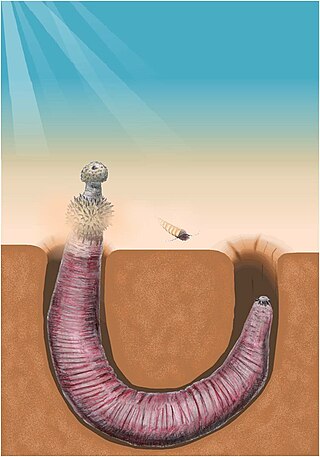
Stachybotrys is a genus of molds, hyphomycetes or asexually reproducing, filamentous fungi, now placed in the family Stachybotryaceae. The genus was erected by August Carl Joseph Corda in 1837. Historically, it was considered closely related to the genus Memnoniella, because the spores are produced in slimy heads rather than in dry chains. Recently, the synonymy of the two genera is generally accepted. Most Stachybotrys species inhabit materials rich in cellulose. The genus has a widespread distribution and contained about 50 species in 2008. There are 88 records of Stachybotrys on Species Fungorum, of which 33 species have DNA sequence data in GenBank. Species in the genus are commonly found in soil, plant litter and air and a few species have been found from damp paper, cotton, linen, cellulose-based building materials water-damaged indoor buildings, and air ducts from both aquatic and terrestrial habitats.
Dactylella is a genus comprising 72 species of mitosporic fungi in the family Orbiliaceae. They are notable for trapping and eating nematodes.
Chrysosporium is a genus of hyaline hyphomycetes fungi in the family Onygenaceae.

Nematophagous fungi are carnivorous fungi specialized in trapping and digesting nematodes. Around 160 species are known. Species exist that live inside the nematodes from the beginning and others that catch them, mostly with glue traps or in rings, some of which constrict on contact. Some species possess both types of traps. Another technique is to stun the nematodes using toxins, a method employed by Coprinus comatus, Stropharia rugosoannulata, and the family Pleurotaceae. The habit of feeding on nematodes has arisen many times among fungi, as is demonstrated by the fact that nematophagous species are found in all major fungal groups. Nematophagous fungi can be useful in controlling those nematodes that eat crops. Purpureocillium, for example, can be used as a bio-nematicide.

The Orbiliaceae are a family of saprobic sac fungi. It is the only family in the monotypic class Orbiliomycetes and the monotypic order Orbiliales. The family was first described by John Axel Nannfeldt in 1932 and now contains 288 species in 12 genera. Members of this family have a widespread distribution, but are more prevalent in temperate regions. Some species in the Orbiliaceae are carnivorous fungi, and have evolved a number of specialized mechanisms to trap nematodes.

The Tiaojishan Formation is a geological formation in Hebei and Liaoning, People's Republic of China, dating to the middle-late Jurassic period. It is known for its exceptionally preserved fossils, including those of plants, insects and vertebrates. It is made up mainly of pyroclastic rock interspersed with basic volcanic and sedimentary rocks. Previously, the Tiaojishan Formation was grouped together with the underlying Haifanggou Formation as a single "Lanqi Formation." The Tiaojishan Formation forms a key part of the Yanliao Biota assemblage, alongside the Haifanggou Formation.

Archaeopriapulida is a group of priapulid worms known from Cambrian lagerstätte. The group is closely related to, and very similar to, the modern Priapulids. It is unclear whether it is mono- or polyphyletic. Despite a remarkable morphological similarity to their modern cousins, they fall outside of the priapulid crown group, which is not unambiguously represented in the fossil record until the Carboniferous. In addition to well-preserved body fossils, remains of several archaeopriapulid taxa are known to have been preserved primarily as organic microfossils, such as isolated scalids and pharyngeal teeth. They are probably closely related or paraphyletic to the palaeoscolecids; the relationship between these basal worms is somewhat unresolved.
Chaetosphaeria is a genus of fungi in the family Chaetosphaeriaceae.
Dactylellina is a genus mitosporic fungi in the family Orbiliaceae. There are 16 species.
Monacrosporium is a genus of fungi in the family Orbiliaceae. There are 53 species.
Stenella is a genus of anamorphic fungi in the family Mycosphaerellaceae. The widespread genus contained about 155 species in 2008.

Sporothrix is a ubiquitous genus of soil-dwelling fungus discovered by Schenck in 1898, and studied in more detail by Hektoen and Perkins. The first described and best known species is Sporothrix schenckii, the causative agent of rose handler's disease. New environmental, and pathogenic, species have been discovered with the potential for more to be found as molecular techniques advance.
Penicillium decumbens is an anamorph species of the genus of Penicillium which occurs widespread in nature, mainly in subtropical and tropical soil but it also occur in food. Analysis have shown that Penicillium decumbens has antibiotic activity Penicillium decumbens produces the cyclopentenone cyclopenicillone
Dactylellina haptotyla is a common soil-living fungus that develops structures to capture nematodes as nutrient source. In the presence of nematodes, spores can germinate into sticky knobs or non-constricting loops. The fungus traps nematodes with sticky knobs and non-constricting loops, then breakdown the cuticle, and penetrates the body of nematodes to obtain nutrients. For its predatory nature, Dactylellina haptotyla is also considered as nematode-trapping fungus or carnivorous fungus.
Gliomastix is a genus of fungi belonging to the family Bionectriaceae.
Dactylaria is a genus of fungi belonging to an unknown family. According to Wijayawardene et al. 2020; the genus was placed in order Helotiales genera incertae sedis.

Dictyosporium is the type genus of fungi belonging to the family Dictyosporiaceae. By an estimate in 2018 it is formed by 45 species.
Monodictys is a genus of fungi of uncertain familial and ordinal placement in the class Ascomycetes. The genus was circumscribed by Welsh-born Canadian mycologist Stanley Hughes in 1956. He assigned Monodictys putredinis as the type species.







